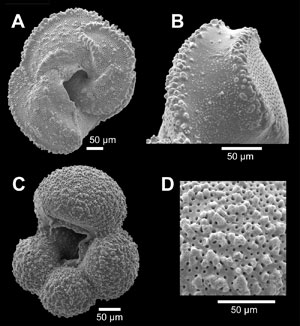|
NEWS NOTES
Ice where no ice should be
 André Bornemann |
| Scientists studied microfossils called foraminifera to determine that ice sheets once existed during a “greenhouse” period 91 million years ago. |
During the Late Cretaceous, deciduous forests covered polar landscapes, and the world was so warm that even turtles and crocodile-like reptiles wandered in the Arctic. So the last thing scientists expected to find were traces of former ice sheets. But researchers say they have the best proof yet that ice existed during this “greenhouse” period, challenging the prevailing wisdom that such balmy climates were ice-free.
The Turonian stage of the Late Cretaceous, 93.5 million to 89.3 million years ago, was one of Earth’s warmest periods over the last 545 million years. Tropical sea-surface temperatures climbed as high as 37 degrees Celsius — at least 5 to 9 degrees warmer than today’s equatorial waters. Most researchers agree ice sheets could not have formed when even the sea-surface temperatures in high-latitude waters exceeded 20 degrees Celsius.
But since the 1980s, researchers have found evidence of large, rapid sea level drops of between 25 and 40 meters in areas off northern Europe, Russia and North America dated to the Late Cretaceous. Some think these declines can only be explained by the formation of ice sheets, which would have trapped large quantities of seawater and thus lowered global sea levels. But geochemical studies of marine microfossils that have been used to support this idea have been unreliable because of large time gaps between data points or poorly preserved samples, says André Bornemann, a paleoceanographer at the University of Leipzig in Germany. Recently, Bornemann and his colleagues analyzed new data recovered from a deep-sea core from the Demerara Rise in the Atlantic Ocean off the coast of northeastern South America that they say confirm the presence of ice in a greenhouse world. “It’s the first reliable dataset from a paleoceanograpic point of view,” Bornemann says.
Bornemann and his colleagues did not find direct evidence of glaciers, such as the remnants of debris trapped by a glacier and subsequently discharged elsewhere. Instead, they studied the ratio of oxygen-18 to oxygen-16 isotopes trapped in well-preserved microfossils called foraminifera, and found an increase in oxygen-18 91.2 million years ago. This suggests ice was present because glaciers preferentially lock in more of water’s “lighter” oxygen-16 isotopes, which leaves behind more oxygen-18 in the oceans for microorganisms to absorb. But these changes could have also been due to changes in seawater temperatures or salinity. Bornemann and his colleagues, however, confirmed that this change was not due to temperature by using a new technique that estimates paleo-temperatures using organic compounds in the lipid membranes of primitive microorganisms.
These data indicate the presence of ice over a 200,000-year period, Bornemann and his colleagues reported Jan. 11 in Science. Given that the continents had not yet settled into their current configuration, Bornemann says he can only speculate where the ice would have formed and if there would have been just one or many ice sheets. His team estimated the volume of ice would have been more than half that of Antarctica’s current ice cap.
“It’s excellent data,” says Kenneth Miller, a micropaleontologist at Rutgers University in Piscataway, N.J., who has studied the possibility of ice during the Late Cretaceous for more than a decade. “It’s quite convincing,” he says.
But staunch advocates of an ice-free greenhouse world may not be convinced. “The data are intriguing,” admits Brian Huber, a paleobiologist at the Smithsonian National Museum of Natural History in Washington, D.C. “But this is just one place where they see this.” Alternative explanations, such as local evaporation in the Atlantic that caused increased salinity in seawater, could also explain the data, he says.
Bornemann says more Turonian-aged data from other regions could further bolster the case for glaciation at this time and could help pinpoint the exact mechanism that allowed ice to form during such a hot period in Earth’s history.

 Subscribe
Subscribe


